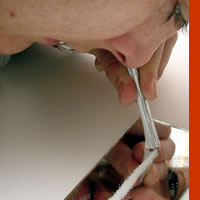JAVIER AVILA
Y ROSA ISELA RUIZ GARCÍA |
| Referencias |
1. J. Cocteau. Opio: diario de una desintoxicación. México: Letras vivas, 1958.
2. S. Siegel. “Learning and the Wisdom of the Body”. Learning & Behavior, 36, (2008): pp. 242-252.
3. S. Siegel. “Pavlovian Conditioning and Drug Overdose: When Tolerance Fails”. Addiction Research & Theory, 9, (2001): pp. 503-513.
4. S. Siegel y B. Ramos. “Applying Laboratory Research: Drug Anticipation and the Treatment of Drug Addiction”. Experimental and Clinical Psychopharmacology, 10, (2002): pp. 162-183.
5. Ch. O’ Brien, Ch. “Adicción y abuso de sustancias tóxicas”, en Godman y Gilman. Bases Farmacológicas de la Terapéutica. Buenos Aires: Panamericana, 1980.
6. S. Siegel, “Morphine Analgesic Tolerance: Its Situation Specificity Supports a Pavlovian Conditioning Model”. Science, 193, (1976): pp. 323-325.
7. S. Siegel. “Morphine Tolerance Acquisition as an Associative Process”. Journal of Experimental Psychology: Animal Behavior Processes, 3, (1977): pp. 1-13.
8. A. J. Goudie. “Conditioned Opponent Processes in the Development of Tolerance to Psychoactive Drugs”. Progress in Neuro-Psychopharmacology & Biological Psychiatry, 14, (1990): pp. 675-688.
9. C. J. Vila. “Protection from Pentobarbital Lethality Mediated by Pavlovian Conditioning”. Pharmacology Biochemistry and Behavior, 32, (1989): pp. 365-366.
10. A. Dickinson y B. Balleine. “Motivational Control of Goal-Directed Action”. Animal Learning & Behavior, 22, (1994): pp. 1–18.
11. L. Hogarth, A. Dickinso, A. Austin, C. Brown y T. Duka. “Attention and Expectation in Human pPredictive Learning: The Role of Uncertainty”. The Quarterly Journal of Experimental Psychology, 61, (2008): pp. 1658-1668.
12. L. Hogarth, A. Dickinson, S. B. Hutton, N. Elbers Y T. Duka. “Drug Expectancy Is Necessary for Stimulus Control of Human Attention, Instrumental Drug-Seeking Behavior and Subjective Pleasure”. Psychopharmacology, 185, (2006): pp. 495–504. |
 |
|